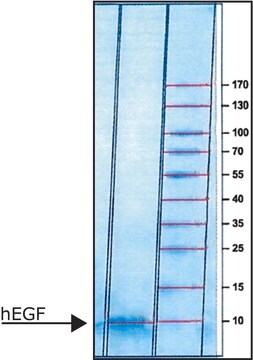11074547001
Roche
Insulin-Transferrin-Sodium Selenite Supplement
suitable for cell culture, lyophilized, pkg of 50 mg (for 5 l medium)
Sinonimo/i:
ITS
Autenticatiper visualizzare i prezzi riservati alla tua organizzazione & contrattuali
About This Item
Codice UNSPSC:
12352207
Prodotti consigliati
Origine biologica
human serum (transferrin)
synthetic (sodium selenite)
Livello qualitativo
Ricombinante
expressed in human cells
Sterilità
non-sterile; 0.2 μm filtered
Saggio
>98% (Transferrin, SDS-PAGE)
>99% (Insulin, HPLC)
>99% (Sodium selenite)
Stato
lyophilized
Confezionamento
pkg of 50 mg (for 5 l medium)
Produttore/marchio commerciale
Roche
tecniche
cell culture | mammalian: suitable
Solubilità
water: miscible
Temperatura di conservazione
2-8°C
Informazioni sul gene
bovine ... INS(280829)
human ... TFRC(7037)
Descrizione generale
The Insulin-Transferrin-Sodium Selenite Supplement contains the most essential growth-promoting components of serum-free culture media in an optimized ratio.
Source: Insulin- bovine pancreas; transferrin- human serum; Sodium selenite-synthetic
Source: Insulin- bovine pancreas; transferrin- human serum; Sodium selenite-synthetic
The insulin-transferrin-sodium selenite (ITS) supplement comprises three of the most crucial growth factors for many cell types. Insulin is a component of serum-free media formulations for all primary cells and cell lines. It stimulates cell growth, increases fatty acid and glycogen synthesis in a serum-free medium. Transferrin is an essential growth factor for many cell types. Selenium is very often necessary for optimal cell growth. ITS permits an appreciable reduction in serum requirements for cellular growth. ITS is also an antioxidant that supports the growth of in vivo derived (IVD) embryos. Insulin promotes embryonic growth and metabolism. The iron transport in the embryo is mediated by transferrin. Sodium selenite protects from oxidative damage and inhibits lipid peroxidation. ITS is useful in human chondrocytes monolayer culture.
Applicazioni
The Insulin-Transferrin-Sodium Selenite Supplement is used in the cell culture media as a basal growth-factor supplement to which other cell type-specific nutrients and growth factors are added.
Nota sulla preparazione
Working concentration: Insulin, 5 μg/ml, transferrin, 5 μg/ml, sodium selenite, 5 ng/ml (3.0 x 10-8 M)
Storage conditions (working solution): -15 to -25 °C.
Prepare appropriate aliquots and avoid repeated freezing and thawing.
Storage conditions (working solution): -15 to -25 °C.
Prepare appropriate aliquots and avoid repeated freezing and thawing.
Ricostituzione
The insulin-transferrin-sodium selenite supplement should be reconstituted in 5 ml or 25 ml sterile double-dist. water (1000 x concentrated stock solution).
Further dilution with culture medium.
Further dilution with culture medium.
Altre note
For life science research only. Not for use in diagnostic procedures.
Codice della classe di stoccaggio
11 - Combustible Solids
Classe di pericolosità dell'acqua (WGK)
WGK 1
Punto d’infiammabilità (°F)
does not flash
Punto d’infiammabilità (°C)
does not flash
Scegli una delle versioni più recenti:
Possiedi già questo prodotto?
I documenti relativi ai prodotti acquistati recentemente sono disponibili nell’Archivio dei documenti.
I clienti hanno visto anche
Imran Khan et al.
Theriogenology, 152, 147-155 (2020-05-16)
Hypothermic storage of gametes and embryos at 4 °C can be used as an alternative to cryopreservation, but hypothermic preservation can maintain embryo viability for a short duration only. This study investigated the effect of insulin-transferrin-sodium selenite (ITS) in embryo culture
K H Chua et al.
European cells & materials, 9, 58-67 (2005-06-18)
This study was to investigate the effects of insulin-transferrin-selenium (ITS) on the proliferation and quantitative gene expression of adult human nasal septum chondrocytes in monolayer culture expansion and the formation of tissue engineered hyaline cartilage. Effects of ITS on human
Milu T Cherian et al.
The Journal of biological chemistry, 287(28), 23368-23380 (2012-05-17)
The androgen receptor (AR) has a critical role in the growth and progression of androgen-dependent and castration-resistant prostate cancers. To identify novel inhibitors of AR transactivation that block growth of prostate cancer cells, a luciferase-based high-throughput screen of ~160,000 small
Catherine Jane Messner et al.
International journal of molecular sciences, 22(18) (2021-09-29)
Liver fibrosis is characterized by the accumulation of extracellular matrix (ECM) resulting in the formation of fibrous scars. In the clinic, liver biopsies are the standard diagnostic method despite the potential for clinical complications. miRNAs are single-stranded, non-coding RNAs that
Jane Ying-Chieh Lee et al.
Frontiers in pharmacology, 7, 81-81 (2016-04-12)
SAHA is a class I HDAC/HDAC6 co-inhibitor and an autophagy inducer currently undergoing clinical investigations in breast cancer patients. However, the molecular mechanism of action of SAHA in breast cancer cells remains unclear. In this study, we found that SAHA
Il team dei nostri ricercatori vanta grande esperienza in tutte le aree della ricerca quali Life Science, scienza dei materiali, sintesi chimica, cromatografia, discipline analitiche, ecc..
Contatta l'Assistenza Tecnica.









